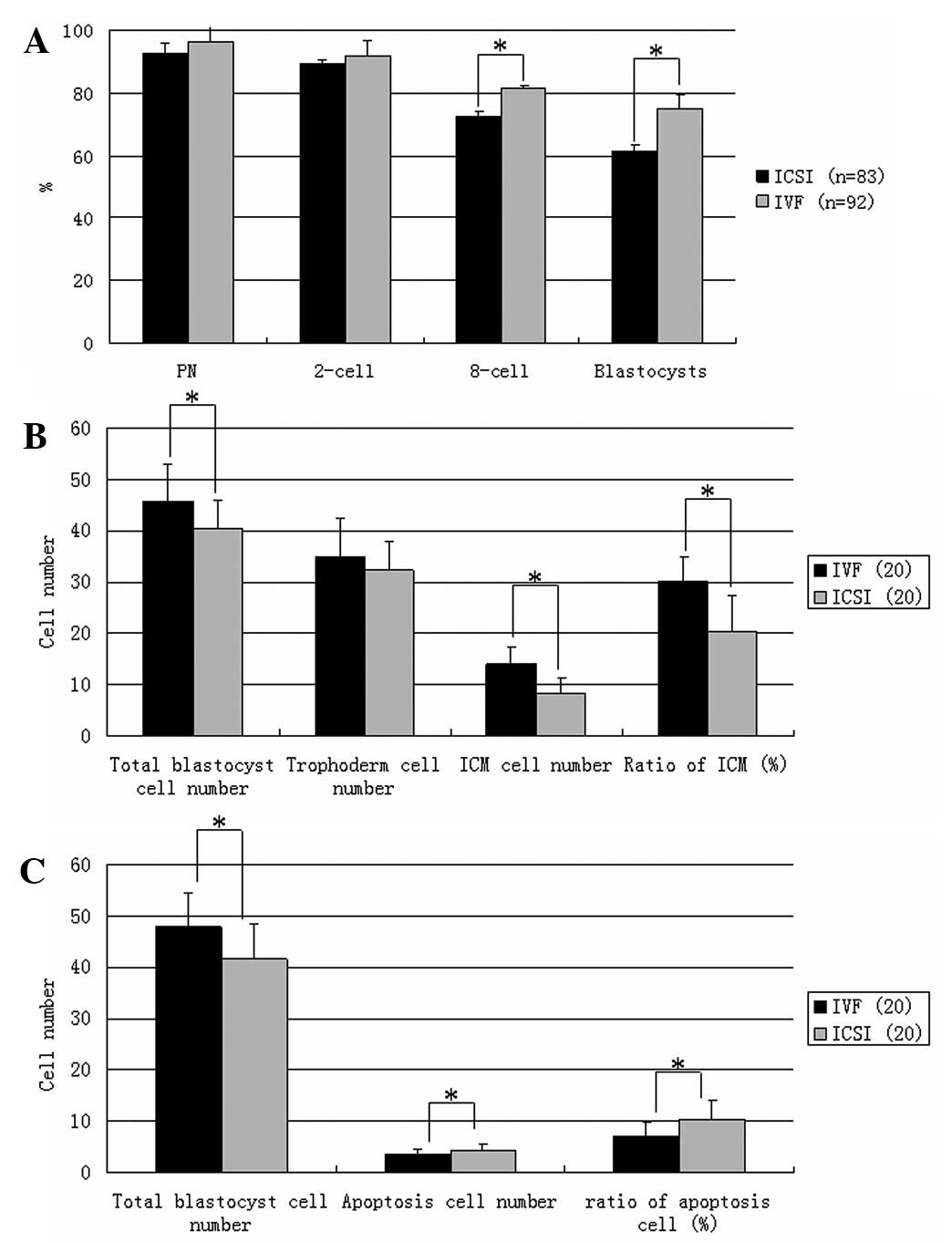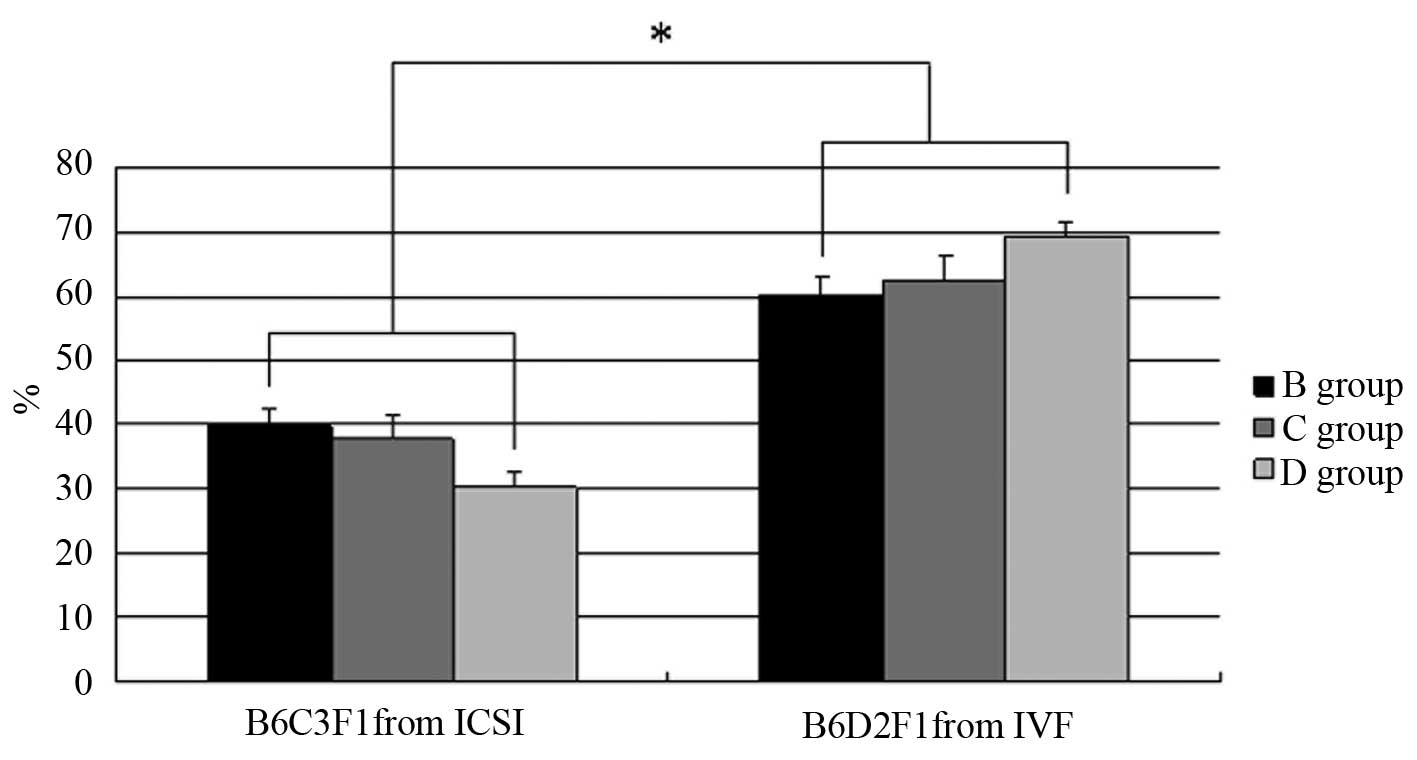|
1
|
Steptoe PC and Edwards RG: Birth after the
reimplantation of a human embryo. Lancet. 2:3661978. View Article : Google Scholar : PubMed/NCBI
|
|
2
|
Palermo G, Joris H, Devroey P and Van
Steirteghem AC: Pregnancies after intracytoplasmic injection of
single spermatozoon into an oocyte. Lancet. 340:17–18. 1992.
View Article : Google Scholar : PubMed/NCBI
|
|
3
|
Handyside AH, Kontogianni EH, Hardy K and
Winston RM: Pregnancies from biopsied human preimplantation embryos
sexed by Y-specific DNA amplification. Nature. 344:768–770. 1990.
View Article : Google Scholar : PubMed/NCBI
|
|
4
|
Calderón G, Belil I, Aran B, et al:
Intracytoplasmic sperm injection versus conventional in-vitro
fertilization: first results. Hum Reprod. 10:2835–2839.
1995.PubMed/NCBI
|
|
5
|
Li Z, Lin H, Xiao W and Wang Y:
Fertilization of IVF/ICSI using sibling oocytes from couples with
subfertile male or unexplained infertility. J Huazhong Univ Sci
Technolog Med Sci. 24:365–368. 2004. View Article : Google Scholar : PubMed/NCBI
|
|
6
|
Elizur SE, Levron J, Seidman DS, et al:
Conventional in vitro fertilization versus intracytoplasmic
sperm injection for sibling oocytes in couples with mild
oligoteratoasthenozoospermia and couples with normal sperm. Fertil
Steril. 82:241–243. 2004.
|
|
7
|
van der Westerlaken L, Naaktgeboren N,
Verburg H, et al: Conventional in vitro fertilization versus
intracytoplasmic sperm injection in patients with borderline semen:
a randomized study using sibling oocytes. Fertil Steril.
85:395–400. 2006.
|
|
8
|
Fan W, Li SW, Li L, et al: Outcome of
conventional IVF and ICSI on sibling oocytes in the case of
isolated teratozoospermia. J Assist Reprod Genet. 29:905–910. 2012.
View Article : Google Scholar : PubMed/NCBI
|
|
9
|
Hwang JL, Seow KM, Lin YH, et al: IVF
versus ICSI in sibling oocytes from patients with polycystic
ovarian syndrome: a randomized controlled trial. Hum Reprod.
20:1261–1265. 2005. View Article : Google Scholar : PubMed/NCBI
|
|
10
|
Staessen C, Camus M, Clasen K, et al:
Conventional in-vitro fertilization versus intracytoplasmic sperm
injection in sibling oocytes from couples with tubal infertility
and normozoospermic semen. Hum Reprod. 14:2474–2479. 1999.
View Article : Google Scholar : PubMed/NCBI
|
|
11
|
Shveiky D, Simon A, Gino H, et al: Sibling
oocyte submission to IVF and ICSI in unexplained infertility
patients: a potential assay for gamete quality. Reprod Biomed
Online. 12:371–374. 2006. View Article : Google Scholar : PubMed/NCBI
|
|
12
|
Plachot M, Belaisch-Allart J, Mayenga JM,
et al: Outcome of conventional IVF and ICSI on sibling oocytes in
mild male factor infertility. Hum Reprod. 17:362–369. 2002.
View Article : Google Scholar : PubMed/NCBI
|
|
13
|
Becker B, Bertrand E, Van Hoeck J, et al:
Outcome of conventional IVF and ICSI on sibling oocytes in patients
suffering from teratospermia. Int J Fertil Womens Med. 51:163–169.
2006.PubMed/NCBI
|
|
14
|
Kihaile PE, Misumi J, Hirotsuru K, et al:
Comparison of sibling oocyte outcomes after intracytoplasmic sperm
injection and in vitro fertilization in severe
teratozoospermic patients in the first cycle. Int J Androl.
26:57–62. 2003. View Article : Google Scholar : PubMed/NCBI
|
|
15
|
Marsh CA, Farr SL, Chang J, et al: Trends
and factors associated with the Day 5 embryo transfer, assisted
reproductive technology surveillance, USA, 2001–2009. Hum Reprod.
27:2325–2331. 2012.PubMed/NCBI
|
|
16
|
Thurin A, Hausken J, Hillensjö T, et al:
Elective single-embryo transfer versus double-embryo transfer in
in vitro fertilization. N Engl J Med. 351:2392–2402. 2004.
View Article : Google Scholar : PubMed/NCBI
|
|
17
|
Gardner DK, Surrey E, Minjarez D, et al:
Single blastocyst transfer: a prospective randomized trial. Fertil
Steril. 81:551–555. 2004. View Article : Google Scholar : PubMed/NCBI
|
|
18
|
Uyar A, Torrealday S and Seli E: Cumulus
and granulosa cell markers of oocyte and embryo quality. Fertil
Steril. 99:979–997. 2013. View Article : Google Scholar : PubMed/NCBI
|
|
19
|
Fragouli E and Wells D: Aneuploidy
screening for embryo selection. Semin Reprod Med. 30:289–301. 2012.
View Article : Google Scholar
|
|
20
|
Yu Y, Ding C, Wang E, et al:
Piezo-assisted nuclear transfer affects cloning efficiency and may
cause apoptosis. Reproduction. 133:947–954. 2007. View Article : Google Scholar : PubMed/NCBI
|
|
21
|
Feng C, Wang LQ, Dong MY and Huang HF:
Assisted reproductive technology may increase clinical mutation
detection in male offspring. Fertil Steril. 90:92–96. 2008.
View Article : Google Scholar : PubMed/NCBI
|
|
22
|
Yu Y, Zhao C, Lv Z, et al: Microinjection
manipulation resulted in the increased apoptosis of spermatocytes
in testes from intracytoplasmic sperm injection (ICSI) derived
mice. PLoS One. 6:e221722011. View Article : Google Scholar : PubMed/NCBI
|
|
23
|
Griffiths TA, Murdoch AP and Herbert M:
Embryonic development in vitro is compromised by the ICSI
procedure. Hum Reprod. 15:1592–1596. 2000.
|
|
24
|
Van Soom A, Vanroose G and de Kruif A:
Blastocyst evaluation by means of differential staining: a
practical approach. Reprod Domest Anim. 36:29–35. 2001.PubMed/NCBI
|
|
25
|
Lane M and Gardner DK: Increase in
postimplantation development of cultured mouse embryos by amino
acids and induction of fetal retardation and exencephaly by
ammonium ions. J Reprod Fertil. 102:305–312. 1994. View Article : Google Scholar : PubMed/NCBI
|
|
26
|
Cao YJ, Fan XJ, Shen Z, et al: Nitric
oxide affects preimplantation embryonic development in a rotating
wall vessel bioreactor simulating microgravity. Cell Biol Int.
31:24–29. 2007. View Article : Google Scholar : PubMed/NCBI
|
|
27
|
Xie Y, Puscheck EE and Rappolee DA:
Effects of SAPK/JNK inhibitors on preimplantation mouse embryo
development are influenced greatly by the amount of stress induced
by the media. Mol Hum Reprod. 12:217–224. 2006. View Article : Google Scholar : PubMed/NCBI
|
|
28
|
Kimura Y and Yanagimachi R:
Intracytoplasmic sperm injection in the mouse. Biol Reprod.
52:709–720. 1995. View Article : Google Scholar : PubMed/NCBI
|
|
29
|
Bhattacharya S, Hamilton MP, Shaaban M, et
al: Conventional in-vitro fertilisation versus intracytoplasmic
sperm injection for the treatment of non-male-factor infertility: a
randomised controlled trial. Lancet. 357:2075–2079. 2001.
View Article : Google Scholar
|
|
30
|
La Sala GB, Nucera G, Gallinelli A, et al:
Spontaneous embryonic loss after in vitro fertilization with
and without intracytoplasmic sperm injection. Fertil Steril.
82:1536–1539. 2004.
|
|
31
|
Hourvitz A, Lerner-Geva L, Elizur SE, et
al: Role of embryo quality in predicting early pregnancy loss
following assisted reproductive technology. Reprod Biomed Online.
13:504–509. 2006. View Article : Google Scholar : PubMed/NCBI
|
|
32
|
Pandian Z, Templeton A, Serour G and
Bhattacharya S: Number of embryos for transfer after IVF and ICSI:
a Cochrane review. Hum Reprod. 20:2681–2687. 2005. View Article : Google Scholar : PubMed/NCBI
|
|
33
|
Gerris J: Single-embryo transfer versus
multiple-embryo transfer. Reprod Biomed Online. 18(Suppl 2): 63–70.
2009. View Article : Google Scholar : PubMed/NCBI
|
|
34
|
Veleva Z, Vilska S, Hydén-Granskog C, et
al: Elective single embryo transfer in women aged 36–39 years. Hum
Reprod. 21:2098–2102. 2006.
|
|
35
|
Montag M, Koll B, Holmes P and van der
Ven: Significance of the number of embryonic cells and the state of
the zona pellucida for hatching of mouse blastocysts in
vitro versus in vivo. Biol Reprod. 62:1738–1744. 2000.
View Article : Google Scholar : PubMed/NCBI
|
|
36
|
Desai NN, Goldstein J, Rowland DY and
Goldfarb JM: Morphological evaluation of human embryos and
derivation of an embryo quality scoring system specific for day 3
embryos: a preliminary study. Hum Reprod. 15:2190–2196. 2000.
View Article : Google Scholar : PubMed/NCBI
|
|
37
|
Wang YA, Sullivan EA, Healy DL and Black
DA: Perinatal outcomes after assisted reproductive technology
treatment in Australia and New Zealand: single versus double embryo
transfer. Med J Aust. 190:234–237. 2009.PubMed/NCBI
|
|
38
|
Rodríguez Barredo DB, Tur Padro R, Mancini
F, Parriego García M, Rodríguez García I, Coroleu Lletget B and
Barri Rague PN: Elective single embryo transfer and cumulative
pregnancy rate: five-year experience in a Southern European
Country. Gynecol Endocrinol. 28:425–428. 2012.PubMed/NCBI
|
|
39
|
Gebhardt KM, Feil DK, Dunning KR, et al:
Human cumulus cell gene expression as a biomarker of pregnancy
outcome after single embryo transfer. Fertil Steril. 96:47–52.
2011. View Article : Google Scholar : PubMed/NCBI
|
|
40
|
McKenzie LJ, Pangas SA, Carson SA, et al:
Human cumulus granulosa cell gene expression: a predictor of
fertilization and embryo selection in women undergoing IVF. Hum
Reprod. 19:2869–2874. 2004. View Article : Google Scholar : PubMed/NCBI
|
|
41
|
Garrido N, Bellver J, Remohí J, et al:
Cumulative newborn rates increase with the total number of
transferred embryos according to an analysis of 15,792 ovum
donation cycles. Fertil Steril. 98:341–346. 2012. View Article : Google Scholar : PubMed/NCBI
|
|
42
|
Garrido N, Bellver J, Remohí J, et al:
Cumulative live-birth rates per total number of embryos needed to
reach newborn in consecutive in vitro fertilization (IVF)
cycles: a new approach to measuring the likelihood of IVF success.
Fertil Steril. 96:40–46. 2011. View Article : Google Scholar : PubMed/NCBI
|
|
43
|
Luke B, Brown MB, Wantman E, et al:
Cumulative birth rates with linked assisted reproductive technology
cycles. N Engl J Med. 366:2483–2491. 2012. View Article : Google Scholar : PubMed/NCBI
|
|
44
|
Malizia BA, Hacker MR and Penzias AS:
Cumulative live-birth rates after in vitro fertilization. N
Engl J Med. 360:236–243. 2009. View Article : Google Scholar : PubMed/NCBI
|
|
45
|
Lannon BM, Choi B, Hacker MR, et al:
Predicting personalized multiple birth risks after in vitro
fertilization-double embryo transfer. Fertil Steril. 98:69–76.
2012. View Article : Google Scholar : PubMed/NCBI
|
















